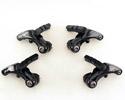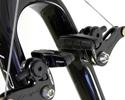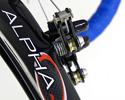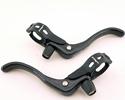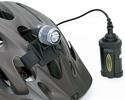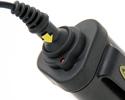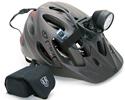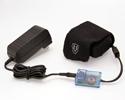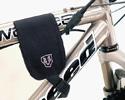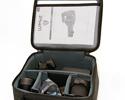
Recently on Cyclingnews.com |
Quick Spins – December 14, 2007Edited by James Huang Got Tech? Send press releases, news, and tech questions to the Cyclingnews tech-heads. Welcome to Quick Spins, an all new section within Cyclingnews' tech coverage were we put some of the smaller items that land on the tech desk to the test.
TRP has quickly moved into the higher-end 'cross brake scene with its CR950 and EuroX cantilevers, and RL950 top-mount levers. The CR950 brakes utilize stout solid carbon fiber arms (no aluminum skeleton here, according to TRP) arranged in a reasonably standard medium-profile configuration that provides a good balance between braking power and mud clearance. They're also light at just 152g per wheel (with pads and titanium mounting hardware), but they don't sacrifice any adjustability in the process: linear pull-style cartridge pads offer a full range of tilt, angle, height, and toe-in settings and each arm sports micro-adjustable return spring tension to dial in the lever feel and centering position. The EuroX cantilevers, on the other hand, embody everything that is both good and bad about this old-school design. They're fantastically light at just 123g per wheel (with pads and hardware), and TRP offers even lighter carbon fiber ones that shed another 22g for a full bike's worth. The high-profile design also delivers heaps of rim and mud clearance, and TRP's Inplace pad holders fit standard Shimano/SRAM-type road cartridges for a wider array of compound choices (especially when using carbon rims). However, as with all brakes of this design, pad adjustments are limited to just tilt and angle (although toe-in on the aluminum version can arguably be adjusted by bending the whole assembly). The RL950 levers continue the lightweight theme with a milled-out hinged aluminum clamp (available in 24, 26, and 31.8mm diameters) and carbon fiber blades for a final weight of just 78g per pair. We started out on the CR950 cantis, and it quickly became obvious why pro riders such as Katie Compton, Tim Johnson, and Lyne Bessette go this route. The well-designed arms offer plenty of power and modulation and are practically flex-free, and the full accoutrement of adjustments allowed for perfect pad positioning. As expected, mud clearance on the medium-profile system could have been a bit better, but it still more than sufficed for all but the nastiest conditions. We were, however, particularly fond of the wide range of spring tension adjustment as it provided as light, or as firm, a pull at the lever as we wanted. Speaking of levers, the RL950 top-mounts worked like a dream with well-shaped blades and smooth pull. The integrated aluminum barrel adjusters came in especially handy as the pads wore. There isn't much else to say here, but they work as advertised, they're light, and they look cool so we have no complaints. Later on in the season we switched to the EuroX arms, and we can see why this design remains so popular on the race circuit as they do provide lots of clearance in the event of a muddy event or a warped wheel. However, that high-profile stance also comes with a low leverage ratio, meaning that lever feel is extremely firm but braking power is modest at best. That wasn't helped by the lack of pad adjustment, either, as we only achieved full pad surface contact after several weeks of wear (ok, a file would have quickened things up here). The limited adjustments also made for more difficult setup and it was virtually impossible to back off the spring tension from its ultra-stiff default setting. In the end, our preference was for the more functional CR950's, which simply delivered better braking performance overall and were far easier to set up. The EuroX brakes work alright, but in our opinion, don't offer enough of a weight savings benefit to justify their use unless you absolutely have to shave every last gram or perpetually find yourself racing in thick dirt soup. Price: US$129.99 (CR950 cantilevers, per wheel, with pads,
straddle cable, and carrier); US$109.99 (EuroX aluminum cantilevers,
per wheel, with two sets of pads, straddle cable, and carrier);
US$69.99 (RL950 levers) |
|
|
|
|
|
LED technology has progressed in leaps and bounds over the past few years. In comparison to HID systems, LED emitters are smaller, lighter, last longer (lifespan, that is, not necessarily burn time), and far more shock-resistant. As a result, the vast majority of high-end lighting systems currently on the market have switched from HID to LED, and Light&Motion's new Stella 180-L is a perfect example why.
The Stella 180-L packs just 180 lumens (its ARC HID big brother churns out up to 675 lumens), but Light&Motion wisely focuses most of that power into a relatively concentrated beam pattern that effectively punches through inky darkness. Nevertheless, it isn't quite powerful enough on its own for really serious trail riding as there isn't much peripheral illumination and the beam is overridden pretty quickly as the speeds climb.
However, it's superb as a supplementary helmet-mounted light for looking around corners, when cresting a rise, or just to peer a little further ahead than your bar-mounted light. When pressed into more casual commuter service, it's also more than adequate for illuminating the path well in front of you or drawing the necessary attention from absentminded drivers.
When factoring in the Stella 180-L's form factor and weight, though, it delivers a mighty impressive little package. The finned aluminum head is about the size of an egg (and we mean a standard medium egg here, not 'Extra Large') and the accompanying Li-ion battery is roughly the same girth as a can of Red Bull but only two-thirds as tall. The entire setup weighs only 288g in helmet-mounted form or a slightly heavier 334g in a handlebar-mounted configuration including Light&Motion's tilt- and angle-adjustable bracket. The five hour burn time on high doesn't hurt, either, nor do its four total brightness settings or two hour recharge time.
The most serious riders will likely want for more output than what the Stella 180-L delivers on its own, but for everyone else, it offers usable power in a wrapper that's lighter and smaller than most with more than enough burn time to get you through the end of your ride.
Price: US$299.95
Pros: Good output with an intelligently shaped beam pattern,
exceptionally small and light, tilt- and angle-adjustable helmet
and bar mounts included, long run time, waterproof connections
Cons: Not quite enough power to run on its own for serious
trail riding, concentrated beam pattern doesn't offer much peripheral
illumination
Cyclingnews rating: ![]()
More info: www.bikelights.com
Photography
For a thumbnail gallery of these images, click here
Images by James Huang/Cyclingnews.com
- The Light&Motion Stella 180-L packs a lot of light in a tiny package.
- The finned aluminum head effectively dissipates heat.
- The head easily pivots from side-to-side to fine tune the aim.
- Light&Motion's helmet mount easily adapts to a variety of helmet models.
- The small connectors fit through most helmet vents for easier cable routing.
- The diminuitive battery quickly drops into a hydration pack or jersey pocket, or can be strapped to a frame tube.
- The 'Multi-Chemistry Charger' makes quick work of a dead battery.
- Waterproof connectors add peace of mind in wet conditions.
- The handlebar mount is adjustable for horizontal and vertical aim and incorporates a breakaway feature (also found in the helmet mount) that can save the lamphead in the event of a crash.
![]()
Lupine Wilma 6 - Pushing LED technology to HID levels
|
|
|
|
|
|
|
|
|
When we tested the Lupine Edison 5 HID lighting system last year, one of our comments was "retina-frying light output" as it was far and away the most powerful bicycle light we'd come across at the time.
Fast forward to 2007, though, and even Lupine itself has abandoned HID technology in favor of LED. As compared to that Edison 5, the new four-LED Wilma 6 pumps out 830 lumens instead of 900 while dropping about 30g from the slightly more compact finned aluminum head. The Wilma 6 also burns for four hours instead of three (with an identical battery), packs the aforementioned durability and longevity benefits of LED, and the emitters are also upgradeable as technology improves. Sounds like a slam dunk to us.
Oh… hold up. While the output of the Wilma head closely mirrors that of the Edison, the relatively even flood pattern is far broader than the Edison's center-concentrated beam. The Wilma lights up more of the periphery as a result but it just doesn't reach as far as the Edison. As a result, we found that we weren't able to ride as fast or as confidently on the trail with the Wilma as we could with the Edison, and we weren't able to highlight certain trail features with the old center-weighted pattern like we used to.
In the end, we preferred using the Wilma in its bar-mounted configuration for general trail illumination and supplemented it with a spot-patterned helmet light (see above). Even then, though, we found a surprisingly amount of room for improvement. Lupine's o-ring mounting system works well on standard diameter bars but is a bear to mount on today's increasingly common oversized pipes (a second o-ring option would be nice). It's also virtually impossible to adjust the lateral aim of the lamp if you're mounting it on a section of handlebar that isn't perfectly perpendicular to dead ahead. In helmet-mounted form, the high-tech PCS7 controller (i.e. the 'on-off' switch) is also a bit tricky to anchor on some models.
Our issues carried over to the battery, too. It's small, compact, and devoid of sharp edges, but the increasing prevalence of oddly-shaped carbon fiber and hydroformed aluminum frames caused some mounting headaches with Lupine's strapping system. Finally, the Wilma 6 is about US$50 cheaper than the Edison (although still US$650!), but its downgraded charger omits the LCD display and diagnostic capabilities of the Edison's killer Charger One version.
Make no mistake, the Wilma is still mega-bright (brighter than nearly all HID systems on the market, in fact) but the Edison absolutely spoiled us on what we expect from a premium lighting system. The Wilma may house cutting-edge LED technology, but we'd like a slightly more concentrated beam pattern and some of the fittings are in desperate need of updating for better compatibility with today's equipment.
Price: US$650
Pros: Broad beam pattern illuminates a lot of trail, HID-beating
lumen output, durability and longevity of LED emitters, upgradeable
head, top-notch construction and quality
Cons: Broad beam pattern doesn't reach far enough ahead,
difficult to mount on some popular configurations, can't adjust
beam laterally, downgraded charger
Cyclingnews rating: ![]()
More info: www.lupine.de
Photography
For a thumbnail gallery of these images, click here
Images by James Huang/Cyclingnews.com
- Lupine's Wilma 6 delivers almost as much light as its Edison HID system.
- Four LEDs combine for an impressive 830 lumen output.
- The versatile helmet mount holds on tight and worked on all helmets tested.
- The aluminum head is finned to dissipate heat.
- Just a simple o-ring keeps the head in place.
- The PCS7 controller includes a lot of features, but is difficult to place on some helmets.
- Waterproof connectors add peace of mind but are difficult to pull apart.
- The tiny battery drives the Wilma 6 for four full hours on the high setting.
- The charger quickly replenishes a dead battery and includes circuitry to prevent frying one.
- The battery strap system works well on some frames, but not so well on others.
- Everything comes packaged in a handy case.
![]()

